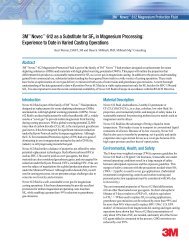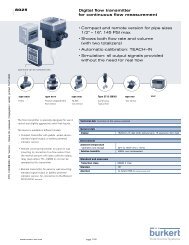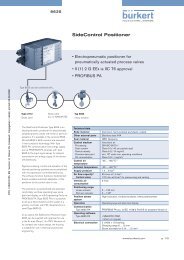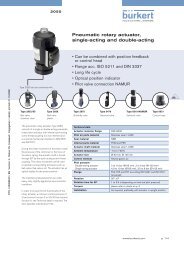Solenoid valves - Bürkert Fluid Control Systems
Solenoid valves - Bürkert Fluid Control Systems
Solenoid valves - Bürkert Fluid Control Systems
You also want an ePaper? Increase the reach of your titles
YUMPU automatically turns print PDFs into web optimized ePapers that Google loves.
1.6.<br />
Special coils<br />
1.6.1. <strong>Solenoid</strong> coils with highperformance<br />
electronics<br />
The highest electrical power is required<br />
by the coil of a solenoid valve when<br />
the core needs to be picked up. As<br />
can be seen from the stroke-force<br />
curves, the coil has the lowest force<br />
of attraction on the solenoid core at<br />
this point. A much lower power is required<br />
to hold the core. For such cases,<br />
Bürkert has developed solenoid coils<br />
with high-performance electronics.<br />
These electronics cause the coil to be<br />
operated with a much higher power for<br />
a brief period until the coil has picked<br />
up the solenoid core. After a period of<br />
approx. 500 ms, an electronic circuit<br />
switches over to a far lower holding<br />
power that does not overload the coil<br />
even in continuous operation. This<br />
means, for example, that much higher<br />
pressures can be switched with the<br />
same coil size than is the case with<br />
standard coils. Other applications are<br />
solenoid systems with a long valve<br />
stroke.<br />
If using <strong>valves</strong> with high-performance<br />
coils, note that the valve must be connected<br />
to an adequately rated power<br />
supply. In addition, the valve may not<br />
switch too frequently since, otherwise,<br />
the coil would be overheated as the<br />
result of excessive coil heating. A maximum<br />
of six switching operations per<br />
minute is considered as the guideline<br />
value.<br />
A distinction is made between two systems:<br />
1. <strong>Solenoid</strong> coils with integrated<br />
electronics<br />
This coil consists of a pick-up winding<br />
and a holding winding which is designed<br />
with corresponding winding parameters<br />
for the required power. This<br />
circuitry must be connected in series<br />
with a rectifier, to enable the valve to<br />
be operated with universal current.<br />
Advantage:<br />
No additional electronics required<br />
Disadvantage:<br />
special coil, more complex, expensive<br />
production, 3 wires.<br />
2. <strong>Solenoid</strong> coil with external<br />
electronics<br />
A standard coil with a higher power<br />
rating is used on this system. Externally<br />
mounted circuitry results in synchronized<br />
control of approx. 1 kHz of<br />
the coil with a specific pulse duty factor<br />
after an overexcitation time of approx.<br />
500 ms. Here as well, the valve<br />
can be operated with universal current.<br />
Advantage:<br />
More favorable, use of standard coils<br />
possible<br />
Disadvantage:<br />
Additional control circuitry required<br />
1.6.2. Impulse coils<br />
Impulse coils require only a brief current<br />
pulse applied to the pick-up winding<br />
for switching. The solenoid core is<br />
energized in this period and held by<br />
integrated permanent magnets. A second<br />
release winding integrated in the<br />
coil results in an opposed force and<br />
the core drops out again. No electrical<br />
power is required for holding the relevant<br />
switch position. Bürkert offers<br />
impulse coils designed as plungertype<br />
and pivoted-armature coils. These<br />
coils, also referred to as “zero-watt<br />
coils”, are used in specific applications.<br />
Typical applications:<br />
■ <strong>Control</strong> from battery supply<br />
■ Undesired coil heating or no heat<br />
applied to the medium<br />
■ Holding the switch position even in<br />
the event of power failure<br />
■ Switching systems with pulse<br />
control.<br />
14/15








